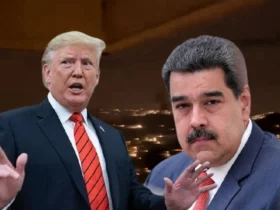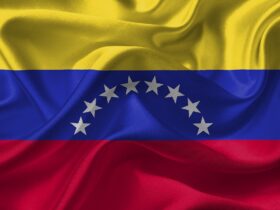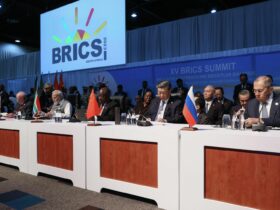In late December, Chinese authorities reported an outbreak of a type of pneumonia of unknown origin in the city of Wuhan. The causative agent of the disease was a new variation of the coronavirus. On February 11, 2020, the World Health Organization named the disease COVID-19. The International Committee on Taxonomy of Viruses (ICTV) then described the virus as “severe acute respiratory syndrome coronavirus 2 (SARS-CoV-2)”.
As of February 19, the number of people infected in China exceeded 74,000. So far, 2,004 people died, while 14,400 patients have recovered. On February 20 the first deaths in the Middle East were reported, both in Iran.
The new virus is genetically related to the coronavirus, which was responsible for the outbreak of Severe Acute Respiratory Syndrome (SARS) in 2003, and also started in China. A total of 8,437 cases of the disease were noted, of which 813 were fatal. Another similar type of coronavirus is Middle East respiratory syndrome coronavirus (MERS-CoV) which broke out in 2012 in Saudi Arabia. According to the WHO, 2,494 people were infected and 858 died from this disease.
Pandemic Now?
The new disease is the deadliest of its kind. Scientists cannot yet come to a consensus about how many more lives it will take. A week ago, Ira Longini, an adviser to the World Health Organization and co-director of the Center for Statistics and Quantitative Infectious Diseases at the University of Florida, predicted that two-thirds of the world’s population could easily become infected with the coronavirus. Other scientists disagreed with her calculations. However, it likely significant that it was an American scientist who spread the apocalyptic forecasts.
In the American media and on social networks, information is circulating that the alleged outbreak could have been a leak from the Wuhan Institute of Virology at the Chinese Academy of Sciences. Allegedly, secret experiments were being conducted there and the virus started as some kind of biological weapon.
These statements are supported by people at high levels: Senate Intelligence Committee Tom Cotton argues that “all” theories of the origin of coronavirus should be considered, including leakage of biological weapons and “deliberate release.”
3. Bad science, bad safety (this is the engineered-bioweapon hypothesis, with an accidental breach)
— Tom Cotton (@SenTomCotton) February 17, 2020
Christian fundamentalists in the United States and other Western countries claim that the new coronavirus is a sign of the apocalypse, one of the four horsemen mentioned in the book of Revelation. According to American right-wing fundamentalists, the new disease alongside the assassination of Qassem Soleimani, the constitutional reforms in Russia and the departure of Prince Harry and Meghan Markle to North America are fulfillments of Biblical prophecy and signs of the end times.
Rick Wiles, a US fundamentalist TV host even declared that the virus is a God’s punishment for China, “a godless state, a godless government, a godless communist government that persecutes Christians.”
Rick Wiles says the coronavirus is a plague sent by God to purge the world of sin as the End Times approach and those who mock God "better wise up because there is a Death Angel on the loose right now and you are going to get an attitude adjustment." https://t.co/UW8ObaHZoG pic.twitter.com/qp0FomKKUw
— Right Wing Watch (@RightWingWatch) January 28, 2020
Radical Jewish Rabbi Yehudah Glick (prominent Temple Mount activist in Israel) also declared that coronavirus is “God’s wrath” on China for human rights abuses.
Similar anti-Chinese sentiments are spreading in Muslim circles around the world. Radical Muslims spread rumors that the coronavirus is retribution by Allah for oppressing Uighurs.
Fake news world war
Against the background of these apocalyptic sentiments and insinuations from the United States, anti-China sentiments are spreading around the world. Sinophobia is aggravated by fears of contracting a disease in light of the media hysteria. American politicians say that they do not trust the official data of the PRC since it is an authoritarian country. Conspiratorial websites and message boards alleged that there are potentially millions of victims.
Coronavirus gave rise to a new outbreak of anti-Chinese sentiment in the Philippines, likely the worst in Southeast Asia. The media is filled with anti-Chinese statements. It is largely aimed against President Rodrigo Duterte who has drawn closer to China during his time in office and recently announced the severance of the Visiting Forces Agreement (VFA) with the US. The hashtag #OustDuterte (“Down with Duterte”) began to spread on Twitter.
“Goodbye America”: What are the consequences of ending the US-Philippines Agreement?
Other countries are also witnessing a rise in Sinophobia. Media panic is changing attitudes towards the Chinese, stigmatizing the entire nation. The Chinese are seen as a threat by many countries around the world, this in turn leads to a decrease in the interaction of Chinese and world business, bans on the entry of Chinese people to other countries and a decrease of demand for Chinese products on foreign markets due to fears of contamination, etc. In the discourse of Western media – it is either the “sick man” of the world, unable to stop the spread of the virus and hiding its terrible consequences, or an open source of danger to everyone else. In the US, this has been superimposed on American officials discussions about the broader Chinese threat.
It should be noted that a significant part of the panic is a fiction created by world media to fit a certain narrative. In general, despite the increase in the number of deaths and the spread of the virus, ordinary flu leads to a much greater number of deaths. Worldwide, flu causes up to 5 million cases of severe illness worldwide and kills up to 650,000 people every year. Yet, there is no widespread panic about influenza.
Coronavirus and Chinese economics
Restrictions on movement within China and the quarantine regime have led to a serious decline in industrial production in China. As a result, global companies have suffered losses. For example, Adidas sales in China dropped by 85% compared to the same period previous year.
According to tech giant Apple, as a result of the coronavirus “worldwide iPhone supply will be temporarily constrained” given that supplies within China have been affected. Apple is now revising its earnings forecast downward.
Due to the coronavirus, Apple has suspended production in China, only now it is resuming production, like many other companies operating in China. However, many workers and employees who went to celebrate Chinese New Year in their hometowns cannot return to work due to restrictions associated with the coronavirus.
Based on the Baidu migration index, the Nomura analytics service reported that only 26.6% of migrant workers from other areas were able to return to work in the 15 cities surveyed.
As a result, experts believe that a massive reduction in shipments and product shortages are imminent. The Taiwan TrendForce agency predicts a massive decrease in technology shipments from China in the first quarter of 2020.
The Japanese newspaper Nikkei writes that “the deadly coronavirus outbreak is taking a toll on China’s manufacturing sector, striking a region crucial to the “Made in China 2025” high-tech initiative as well as a hub for the automotive industry.”
The Hubei Province, of which Wuhan is capital, is ground zero for the new disease and now is completely quarantined. It is worth noting that this region makes up 4% of China’s total economy, and is often called “Chicago of the East.” There are numerous important production facilities there including the artificial intelligence development center of Xiaomi, General Motors factories, Honda and Groupe PSA as well as the Chinese Dongfeng Motor Group, and many other Chinese and international industries.
According to Goldman Sachs analyst Adam Gillard, demand across the board is down 66% in comparison to previous years.
A drop in domestic demand and production is a serious threat that poses problems for the Chinese economy if the government does not manage to cope with the coronavirus epidemic in the coming months.
The end of the Chinese New Year
February 3 saw a sharp drop in the Chinese stock market at the opening of exchanges. The collapse in market capitalization exceeded more than $350 billion, and 8–9% Yuan depreciation compared to world currencies.
On the verge of a global crisis?
There are fears that the problems in the Chinese economy caused by the coronaviurus could lead to a global economic crisis. For example, disruption in the supply of raw materials for the Indian pharmaceutical industry could affect this important sector of the economy for India.
According to Pankaj R. Patel, the chairman of Zydus Cadila, leading Indian pharmaceutical company prices in India have exponentially risen in the last several weeks, as much of the medicine is sourced from China. If the situation does not change in the next two weeks, India could face shortages in finished drug formulations starting April.
Serious economic problems due to the coronavirus are also expected in Japan. Richard Koo, chief economist at Nomura Research Institute declares, that ”the coronavirus will probably cause a substantial amount of economic damage in Japan.”
Oil and liquefied gas producers may already be facing serious problems. The contraction of production in China has led to a drop in energy consumption; there are reports that for “the last couple of weeks, major LNG export cargoes to China have been diverted to other clients or are still looking for a destination in an already woefully oversupplied market.”
This situation could cause serious problems in the global energy market, primarily when it comes to LNG. Qatar, Algeria, Egypt will be the first to have difficulties, followed by US shale gas producers.
A significant decrease in oil consumption is also predicted, which may primarily affect the Persian Gulf countries, most of which oil goes to the Asia-Pacific region and, above all, to China. The more difficult the general economic situation of the country, the more it will be affected by a decrease in oil consumption. Thus, this problem may affect Iran most sensitively.
A geopolitical blow
According to several world news agencies, the outbreak of coronavirus will negatively affect the development of the Chinese “One Belt, One Road” project, also called the Belt and Road Initiative (BRI). Until the outbreak, the initiative helped Chinese workers get jobs abroad, and the fundamental feature of Chinese projects under the BRI is the use of Chinese, rather than domestic labor. Supply chains critical to the project have also been interrupted.
“Since many BRI projects tend to source equipment and machinery from manufacturers based in China, the disruptions in industrial production and supply chain will cause further delays,” said Boyang Xue, a China analyst at Ducker Frontier cited by Reuters.
So far, the only country that has benefited from the coronavirus outbreak has been the United States. The consequences of the epidemic, how it is perceived through the media in the public mind, its impact on the Chinese economy, and therefore, on Chinese geopolitical power, are all beneficial to Washington. Washington is interested in weakening its geopolitical adversary and its largest project – the BRI. Therefore, there are even theories that the outbreak of a new virus was a result of American sabotage.
One way or another, the US has actively taken advantage of the epidemic. If the conclusion of the first phase of the trade transactions was perceived as a temporary truce in the confrontation between the two countries, the United States is now going on the offensive. The position of the part of the American establishment which advocates confrontation with China has strengthened.
At the Munich Security Conference, US Secretary of Defense Mark Esper intimidated Europeans with the “Chinese threat.”
A week earlier, Secretary of State Mike Pompeo was frightening US governors with tales of Chinese Communist infiltration into schools and universities.
Top 5 takeaways from Munich Security Conference: Spengler, China, Europe, the US and Realpolitik
Earlier, US Commerce Secretary Wilbur Ross mentioned that the coronavirus “accelerates the return of jobs to North America,” one of the main goals of Donald Trump’s administration.
The future of the multipolar world depends on how quickly China can cope with the coronavirus. Beijing needs not only to fight the disease, but also to solve its geopolitical consequences. So far, the US has been successfully taking advantage of the situation with coronavirus, weakening China’s position as an alternative financial and industrial center and curtailing its threat to Washington’s world hegemony.
However, a number of important steps are already being taken. Chinese authorities have imposed limits on the acquisition of shares by foreign residents in the amount of more than $ 10 million. Thus, the access of foreign speculators to the possibility of buying up Chinese assets at a lower cost has been limited. There is also information that Beijing plans to nationalize one of the largest industrial conglomerates of the HNA Group. At the same time, the country has made remarkable strides in studying and containing the disease, winning the praise of the WHO and other international bodies for its efficiency and swiftness. While the US has been able to capitalize on the outbreak in the short term, Beijing’s ability to rise to the challenge might even serve as a testament to the government’s stability during a time of crisis, which could help inspire economic confidence in the long run.

















Leave a Reply